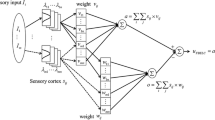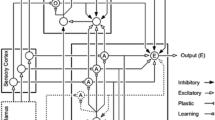Abstract
Brain emotional learning-inspired models (BELiMs) is a new category of computational intelligence (CI) paradigms. The general structure of BELiMs is based on the neural structure of the emotion system which processes and evaluates fear-induced stimuli, to produce emotional responses. The function of a BELiM is implemented by assigning adaptive networks to different parts of its structure. The primary motivation for developing BELiMs is to address model and time complexity issues associated with supervised machine learning artificial neural networks and neuro-fuzzy methods. One of the applications of BELiMs is chaotic time series prediction problems. A BEliM can be used as a time series prediction model. This paper introduces BELiMs as a new CI paradigm and explains historical, theoretical, structural and functional aspects of BELiMs. I also validate and evaluate the performance of BELiMs as a time series prediction model by examining different variations of BELiMs on benchmark time series data sets and comparing obtained results with different CI models.





















Similar content being viewed by others
Notes
Which means that they need a large number of computational resources for solving problems.
It is responsible for generating fear reactions and is an essential component of a mammal’s survival circuit.
It can be considered as one function of the emotional system of fear, is a kind of behaviour that an organism presents to predict aversive events by learning a connection between an aversive stimulus and a neutral stimulus (Maren 2001).
Walter Bradford Cannon was a physiologist at Harvard University, and Philip Bard was a doctoral student of Cannon.
James Wenceslas Papez was an American neuroanatomist.
Paul D. MacLean was an American physician, and neuroscientist.
It is a behavioural paradigm that is used by mammalians not only to predict the occurrence of fearful stimuli but also to learn to avoid the origins of fearful stimuli.
The terminology of BELs, first time presented by Parsapoor and Bilstrup (2013c).
An extended abstract submitted in FORGES-2008 (http://crd.yerphi.am/FORGES2008).
The paper completely explained BELRFS and presented its results as a time series prediction model and compared its obtained results with powerful MLs such as ANFIS.
Where (x(t), y(t), z(t)) are coordinates in the 3D space. There are three constants as \(\sigma \), \(\rho \) and \(\beta \) and three variables as (x(t), y(t), z(t)).
Sunspots are “cool planet-sized areas on the Sun where intense magnetic loops poke through the star’s visible surface” (The Sunspot Number 2015).
Solar activity forecasting is necessary to predict changes in the space environment between the Earth and Sun and protect damages to space weather and ground-based communication tools.
References
Ardalani-Farsa M, Zolfaghari S (2011) Residual analysis and combination of embedding theorem and artificial intelligence in chaotic time series forecasting. Appl Artif Intell 25(1):45–73. https://doi.org/10.1080/08839514.2011.529263
Babaie T, Karimizandi R, Lucas C (2008) Learning based brain emotional intelligence as a new aspect for development of an alarm system. Soft Comput 12(9):857–873
Cannon WB (1927) The James-Lange theory of emotions: a critical examination and an alternative theory. Am J Psychol 39:106–124
Chandra R, Zhang M (2012) Cooperative coevolution of Elman recurrent neural networks for chaotic time series prediction. Neurocomputing 86:116–123
Christopher LH (2015) Psychology 101. http://allpsych.com/psychology101/. Accessed 30 Jan 2015
Dalgleish T (2004) The emotional brain. Nat Rev Neurosci 5(7):583–589
Damasio AR (1995) Descartes’ error: emotion, reason, and the human brain, 1st edn. Harper Perennial, New York City
Darwin C (1872) The expression of the emotions in man and animals 1872. The original was published 1898 by Appleton, New York. Reprinted 1965 by the University of Chicago Press, Chicago and London
Ekman P (2004) Emotional and conversational nonverbal signals. In: Language, knowledge, and representation. Springer, Berlin, pp 39–50
Engelbrecht AP (2007) Computational intelligence: an introduction. Wiley, Hoboken
Fellous J, Armony J, LeDoux J (2002) Emotional circuits and computational neuroscience. Handb Brain Theory Neural Netw 2:30–31
Gholipour A, Lucas C, Araabi BN, Shafiee M (2005) Solar activity forecast: spectral analysis and neurofuzzy prediction. J Atmos Solar Terr Phys 67(6):595–603
Gholipour A, Araabi BN, Lucas C (2006) Predicting chaotic time series using neural and neurofuzzy models: a comparative study. Neural Process Lett 24(3):217–239
Gregory J (2015) Theories of emotion. http://www.iep.utm.edu/home/about/. Accessed 30 Jan 2015
Harlow JM (1999) Passage of an iron rod through the head. 1848. J Neuropsychiatry Clin Neurosci 11(2):281–283
James W (1884) What is an emotion? Mind 9:188–205
Jang JSR, Sun CT, Mizutani E (1997) Neuro-fuzzy and soft computing: a computational approach to learning and machine intelligence. MATLAB curriculum series. Prentice-Hall, Englewood Cliffs
LeDoux J (1998) The emotional brain: the mysterious underpinnings of emotional life. Simon and Schuster, New York, p 1998
LeDoux J (2003) The emotional brain, fear, and the amygdala. Cell Mol Neurobiol 23(4–5):727–738
LeDoux J (2008a) Amygdala. Scholarpedia 3(4):2698
LeDoux JE (2008b) Amygdala. Scholarpedia 3(4):2698 (Revision 137109)
Lucas C, Abbaspour A, Gholipour A, Araabi B, Fatourechi M (2003) Enhancing the performance of neurofuzzy predictors by emotional learning algorithm. Informatica 27(2):137–146
Lucas C, Shahmirzadi D, Sheikholeslami N (2004) Introducing belbic: brain emotional learning based intelligent controller. Intell Autom Soft Comput 10(1):11–21
Ma Q-L, Zheng Q-L, Peng H, Zhong T-W, Xu L-Q (2007) Chaotic time series prediction based on evolving recurrent neural networks. In: 2007 International conference on machine learning and cybernetics, vol 6. IEEE, pp 3496–3500
Maren S (2001) Neurobiology of pavlovian fear conditioning. Annu Rev Neurosci 24(1):897–931
Maris G, Oncica A (2006) Solar cycle 24 forecasts. Sun Geospace 1(8):11
Mirmomeni M, Kamaliha E, Shafiee M, Lucas C (2009) Long-term prediction of solar and geomagnetic activity daily time series using singular spectrum analysis and fuzzy descriptor models. Earth Planets Space 61(9):1089–1101
Moren J (2002) Emotion and learning—a computational model of the Amygdala. PhD thesis
Morén J, Balkenius C (2000) A computational model of emotional learning in the amygdala. In: From animals to animats: the 6th international conference on the simulation of adaptive behavior. MIT Press
Nelles O (2001) Nonlinear system identification: from classical approaches to neural networks and fuzzy models. Engineering online library, Springer, Berlin. ISBN 9783540673699. https://books.google.de/books?id=7qHDgwMRqM4C
Papez JW (1937) A proposed mechanism of emotion. Arch Neurol Psychiatry 38(4):725–743
Parsapoor M (2014) Brain emotional learning-inspired models
Parsapoor M (2015) Towards emotion-inspired computational intelligence (EiCI). PhD thesis, Halmstad University
Parsapoor M, Bilstrup U (2012a) Brain emotional learning based fuzzyinference system (BELFIS) for solar activity forecasting. In: 2012 IEEE 24th international conference on tools with artificial intelligence (ICTAI), vol 1. IEEE, pp 532–539
Parsapoor M, Bilstrup U (2012b) Neuro-fuzzy models, BELRFS and LOLIMOT, for prediction of chaotic time series. International symposium on innovations in intelligent systems and applications (INISTA 2012), Trabzon, Turkey. July. IEEE Press, New York, pp 2–4
Parsapoor M, Bilstrup U (2013a) Brain emotional learning based fuzzyinference system (modified using radial basis function). In: 2013 8th international conference on digital information management (ICDIM), pp 206–211
Parsapoor M, Bilstrup U (2013b) An emotional learning-inspired ensemble classifier (ELiEC). In: 2013 Federated conference on computer science and informationsystems (FedCSIS), pp 137–141
Parsapoor M, Bilstrup U (2013c) Chaotic time series prediction using brain emotional learning-based recurrent fuzzy system (belrfs). Int J Reason Based Intell Syst 5(2):113–126
Parsapoor M, Bilstrup U (2013d) Brain emotional learning based fuzzy inference system (modified using radial basis function). In: 2013 8th international conference on digital information management (ICDIM). IEEE, pp 206–211
Parsapoor M, Lucas C (2008a) Modifying brain emotional learning model for adaptive prediction of chaotic systems with limited datatraining samples. In: 1st international conference on applied operational research, pp 328–341
Parsapoor M (2008) Lucas C (2008b) Predicting of solar geomagnetic. Forecasting Of the radiation and geomagnetic storms (FORGES, Indices by utilizing the. Emotional Learning Method
Parsapoor M, Lucas C, Setayeshi S (2008) Reinforcement \_recurrent fuzzy rule based system based on brain emotional learning structure to predict the complexity dynamic system. In: 2008 3rd international conference on digital information management
Parsapoor M, Bilstrup U, Svensson B (2014a) A brain emotional learning-based prediction model for the prediction of geomagnetic storms. In: 2014 federated conference on computer science and information systems (FedCSIS), pp 35–42
Parsapoor M, Bilstrup U, Svensson B (2014b) Neuro-fuzzy models for geomagnetic storms prediction: using the auroral electrojet index. In: 2014 10th international conference on natural computation (ICNC), pp 12–17
Parsapoor M, Bilstrup U, Svensson B (2015a) Prediction of solar cycle 24. In: 2015 International joint conference on neural networks (IJCNN), pp 1–8
Parsapoor M, Bilstrup U, Svensson B (2015b) Prediction of solar cycle 24. In: 2015 International joint conference on neural networks (IJCNN). IEEE, pp 1–8
Parsapoor M, Brooke J, Svensson B (2015c) A new computational intelligence model for long-term prediction of solar and geomagnetic activity
Pavlov PI (2010) Conditioned reflexes: an investigation of the physiological activity of the cerebral cortex. Ann Neurosci 17(3):136
Pesnell WD (2008) Predictions of solar cycle 24. Sol Phys 252(1):209–220
Plutchik R (2001) The nature of emotions human emotions have deep evolutionary roots, a fact that may explain their complexity and provide tools for clinical practice
Reisberg D (2005) Cognition: exploring the science of the mind, 3rd edn. WW Norton, New York. http://www.wwnorton.com/college/titles/psych/cog3/
Schachter S, Singer J (1962) Cognitive, social, and physiological determinants of emotional state. Psychol Rev 69(5):379
Scherer KR, Bänziger T, Roesch E (2010) A blueprint for affective computing: a sourcebook and manual. Oxford University Press, Oxford
Tompkins S (1962) Affect imagery consciousness: volume I: the positive affects. Springer Series. Springer Publishing Company, Berlin. ISBN 9780826104427. https://books.google.ca/books?id=WIpgNerqaIkC
The Sunspot Number (2015) http://spaceweather.com/glossary/sunspotnumber.html. Accessed 30 Jan 2015
Acknowledgements
This paper is a summary version of the author’s licentiate thesis called “Brain emotional Learning-inspired Models” and PhD dissertation entitled “Towards emotion inspired computational intelligence.” Thus, the author would like to express her gratefulness to, Professor Bertil Svensson (my principal supervisor) and Professor Urban Bilstrup (my co-supervisor), who provided her with the precious opportunity to work on and develop BELiMs and complete her PhD thesis. The author would like to offer her sincerest thanks to the late Professor Caro Lucas for his inspiration and kind support in supervising me throughout her research process concerning the development the brain emotional learning- based prediction models. The author is also thankful for the financial support of the Knowledge Foundation and CERES (The Centre for Research on Embedded Systems) Also, the authors are grateful for accessing sunspot number data provided by NOAA and World Data Center for Geomagnetism and Space Magnetism, Kyoto University.
Author information
Authors and Affiliations
Corresponding author
Rights and permissions
About this article
Cite this article
Parsapoor, M. An introduction to brain emotional learning inspired models (BELiMs) with an example of BELiMs’ applications. Artif Intell Rev 52, 409–439 (2019). https://doi.org/10.1007/s10462-018-9638-y
Published:
Issue Date:
DOI: https://doi.org/10.1007/s10462-018-9638-y




